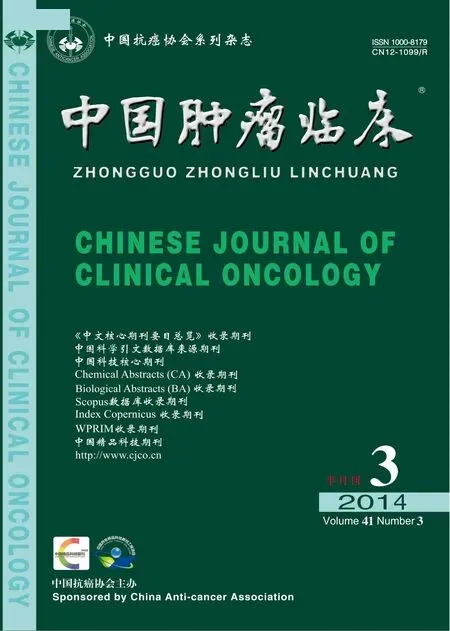家族性非髓样甲状腺癌候选致病基因的研究及展望*
高 明 于 洋 贾永胜
家族性非髓样甲状腺癌候选致病基因的研究及展望*
高 明 于 洋 贾永胜
家族性非髓样甲状腺癌为一级亲属中有2例或2例以上甲状腺滤泡上皮细胞起源的甲状腺癌患者的家族,并排除甲状腺癌致病因素暴露史。家族性非髓样甲状腺癌是一种常见的肿瘤性遗传病。与散发性非髓样甲状腺癌相比,家族性非髓样甲状腺癌发病年龄更低,发病率更高且转移率更高。因此,一般认为家族性非髓样甲状腺癌的预后更差。尽管已有部分报道,但家族性非髓样甲状腺癌的致病基因尚未明确。全基因组外显子测序技术以其快速、高通量以及低成本而被广泛应用,因此适用于寻找家族性非髓样甲状腺癌的致病基因或易感基因。
家族性非髓样甲状腺癌 致癌基因 全基因组外显子测序
家族性非髓样甲状腺癌(familial non-medullary thyroid carcinoma,FNMTC)家系的定义为:一级亲属中有2例或2例以上甲状腺滤泡上皮细胞起源的甲状腺癌患者的家族,并排除甲状腺癌致病因素暴露史。以往认为FNMTC家系在临床上罕见,并未引起足够重视,因此对其相关报道甚少。近年研究发现,约10%的非髓样甲状腺癌(non-medullary thyroid carcinoma,NMTC)患者都具有家族史[1-4],在临床有相当一部分患者都患有家族性甲状腺癌。10%的家族遗传病例足以说明FNMTC具有很高的遗传倾向性,严重危害人类健康。遗憾的是,由于以前对FNMTC认识不足,临床对FNMTC的致病基因、临床特点及治疗原则均不明确。因此,对于FNMTC的研究应给予足够的重视[5]。依据 OMIM(Online Mendelian Inheritance in Man,OMIM)的信息统计,到目前为止,已发现约有2 400个致病基因和单基因病有关,另外约有1 600多个单基因病已有较明确的致病位点,但尚未克隆出致病基因。因此,进行FNMTC致病基因的定位、克隆,将为明确FNMTC的分子诊断、分子分型、诊断和治疗奠定重要理论基础,为以后基因治疗提供可能。此类研究具有重要的理论价值和社会现实意义。
1 家族性非髓样甲状腺癌的临床表现及流行病学研究
FNMTC可单独发病或作为家族性肿瘤综合征如Gardner综合征(家族性腺瘤样息肉病)、Cowden病或其他罕见综合征的一部分发生。其中绝大多数FNMTC属于单独发生。从组织学角度分析,FNMTC多为家族性甲状腺乳头状癌,约占90%,其余为滤泡型甲状腺癌(包括Hurthle细胞瘤)。由于很少合并家族性肿瘤综合征且病理类型都属于最常见者,FNMTC的确诊就更加隐匿,单从临床表现上很难对家族性与散发性患者进行鉴别。因此,阐明其致病基因,明确其分子诊断方法,对患者筛查及改善预后有着极为重大的意义。
流行病学研究表明,FNMTC患者的一级亲属中该病的发病率比普通人群高,其患病风险升高4~10倍[6]。3.5%~6.2%的NMTC患者可发现家族成员患病[7]。多数研究表明,FNMTC与散发性NMTC相比,具有更高的侵袭性。双侧或多发病灶是FNMTC的主要临床特征之一。FNMTC预后较差,区域淋巴结转移、腺外侵犯、肿瘤腺体内播散、合并多发性良性病变的比例均较散发性者高[8-9]。多因素统计显示FNMTC是NMTC无瘤生存期变短的最主要因素[8]。有研究显示,家族性非髓样甲状腺癌发病年龄更早(39岁vs.46岁),多灶性比例更高(75%vs.43.3%)且复发率更高(44%vs.17%)[9]。FNMTC行全甲状腺切除及区域淋巴结清扫术后常规行放射性碘治疗及内分泌抑制治疗,其长期生存不比散发性NMTC差[10]。以上说明,FNMTC的侵袭性更强,预后更差。对FNMTC采取积极的治疗手段,可以改善其预后,而对FNMTC的早期诊断就成为影响预后的关键所在。
2 家族性非髓样甲状腺癌候选致病基因的研究
对于遗传性疾病研究,家系的选择至关重要。FNMTC属于遗传性疾病,但在一个家系中出现2例NMTC并不表示其一定具有遗传性,其发生可能与共同暴露于易感因素有关。Charkes通过分析研究认为,如果家族一级亲属中只有2例非髓样癌患者,此家族具有遗传性的概率只有31%~38%;若一级亲属中有3个或3个以上患者,此家族具有遗传性的概率则大于94%,从这一点上来讲,研究对象家系的选择十分重要[11]。虽然FNMTC的概念提出至今已近50年,但由于技术方法的限制和样本选择偏差等原因,至今,与FNMTC发生相关的特异性致病基因仍未能被阐明。现有观点认为它可能由抑癌基因突变所致,为常染色体显性遗传病,但目前除了少数合并有NMTC的家族性肿瘤综合征外,对于那些单独发病的FNMTC的分子遗传学所知甚少[12-15]。有研究表明多个染色体位点可能与FNMTC的发生有关。第一个被提出的位点为MNG1(14q32),然而在随后的研究中发现,此位点的突变也见于其他多发甲状腺肿物的患者。之后有研究显示TCO(19p13.2)可能为FNMTC的致病基因,但此结果颇有争议。反对者提出,此位点的基因突变也见于散发性甲状腺非髓样甲状腺癌患者。fPTC=PRN(1q21)位点只在一个FNMTC家系中被证实,在其他家系中缺乏进一步的研究。NMTC1(2q21)在3个不同的研究中被证实,但亦有少数研究不支持此结论。FTEN(8p23.1~p22)与fPTC=PRN(1q21)位点一样,只在一个FNMTC家系中被证实,在其他家系的研究中缺乏可重复性[16-17]。
MAPK信号传导通路的异常激活是甲状腺癌发生的重要原因,目前的研究已经排除了该信号传导通路一些可疑基因导致FNMTC发病的可能性,包括Ras基因突变,RET/PTC基因重排,BRAF基因突变以及TRK、MET、APC、PTEN、JUNB以及 TSHR基因突变等[18-19]。此外还有研究显示,SNP可能与FNMTC的发病直接相关,但已报道的SNP位点均远离现有的已知基因。有报道指出,这些SNP可能与mRNA的表达有关,但均未能提供充足的证据给予支持,但SNP仍被认为是最可能的致病原因之一[20-21]。
3 致病基因的研究方法
近年来,众多研究小组开展了大量的全基因组关联研究(genome-wide association studies,GWAS),发现并鉴定了许多与复杂疾病相关联的遗传变异,为复杂疾病发病机制的研究提供了重要线索。由于GWAS的结果存在假阳性、假阴性、检测到的单核苷酸多态性很少位于功能区以及对稀有变异和结构变异不敏感等问题的存在,导致了其应用的局限性。一直以来,单基因病致病基因的克隆常采用传统的候选基因定位克隆技术,然而传统的定位克隆技术常常会因为家系内成员太少、基因位点的异质性、外显不全及定位区间内候选克隆基因太多等而受到限制。新一代测序技术的进步,促进了全基因组测序和全基因组外显子测序的快速发展,也为解决上述问题提供了契机。全基因外显子组捕获结合高通量测序,一次可获得全部外显子的信息,从根本上解决了传统克隆致病基因的难题。
全基因组外显子测序是利用序列捕获技术将全基因组外显子区域DNA捕捉并富集后进行高通量测序的基因组分析方法。此技术在米勒综合症的研究中首次得到成功的应用[22],随后通过此项技术发现了歌舞伎综合症[23]、重型颅脑畸形[24]等孟德尔疾病的新的致病基因突变。最近,应用外显子组测序发现了家族性低β脂蛋白血症的一个新的致病突变[25],该疾病是一种脂质代谢障碍的复杂疾病。由于其具有对常见和罕见变异的高灵敏度,能发现外显子区绝大部分疾病相关变异以及仅需要对约1%的基因组进行测序等优点,促使全基因组外显子测序成为鉴定孟德尔疾病的致病基因最有效的策略,也被运用于复杂疾病易感基因的研究和临床诊断中。这些结果都表明全基因组外显子测序技术适用于寻找单基因疾病、复杂疾病(如糖尿病、肥胖症等代谢综合症)、以至癌症的致病基因或易感基因。
4 展望
前期对多个家系的研究已发现多个结构与功能均未明确的新基因。相信通过对该基因进一步的功能分析以及明确该致病基因的生物学功能,可以进一步阐明FNMTC的分子发病机制,优化早期诊断和治疗方法,以及提高高危家庭成员的筛查率。
1 Moses W,Weng J,Kebebew E.revalence,clinicopathologic features,and somatic genetic mutation profile in familial versus sporadic nonmedullary thyroid cancer[J].Thyroid,2011,21(4):367-371.
2 McDonald TJ,Driedger AA,Garcia BM,et al.Familial papillary thyroid carcinoma:a retrospective analysis[J].J Oncol,2011,2011:948786.
3 Mazeh H,Benavidez J,Poehls JL,et al.In patients with thyroid cancer of follicular cell origin,a family history of nonmedullary thyroid cancer in one first-degree relative is associated with more aggressive disease[J].Thyroid,2012,22(1):3-8.
4 Park YJ,Ahn HY,Choi HS,et al.The long-term out-comes of the second generation of familial nonmewdullary thyroid carcinoma are more aggressive than sporadic cases[J].Thyroid,2012,22(4):356-362.
5 Albert de la Chapelle,Krystian Jazdzewski.MicroRNAs in Thyroid Cancer[J].J Clin Endocrinol Metab,2011,96(11):3326-3336.
6 Frich L,Glattre E,Akslen L A.Familial occurrence of nonmedullary thyroid cancer:a population-based study of 5673 first-degree relatives of thyroid cancer patients from Norway[J].Cancer Epidemiol Biomarkers Prev,2001,10(2):113-114.
7 Ruben Harach H.Familial nonmedullary thyroid neoplasia[J].Endocr Pathol,2001,12(2):97-99.
8 Uchino S,Noguchi S,Kawamoto H,et al.Familial nonmedullary thyroid carcinoma characterized by multifocality and a high recurrence rate in a large study population[J].World J Surg,2002,26(8):897-900.
9 Capezzone M,Marchisotta S,Cantara S,et al.Familial non-medullary thyroid carcinoma displays the features of clinical anticipation suggestive of a distinct biological entity[J].Endocr Relat Cancer,2008,15(3):1075-1081.
10 Robenshtok E,Tzvetov G,Grozinsky-Glasberg S,et al.Clinical characteristics and outcome of familial nonmedullary thyroid cancer:a retrospective controlled study[J].Thyroid,2011,21(1):43-48.
11 Charkes ND.On the prevalence of familial non-medullary thyroid cancer in multiply affected kindreds[J].Thyroid,2006,16(2):181-186.
12 Tomaz RA,Sousa I,Silva JG,et al.FOXE1 polymorphisms are associated with familial and sporadic nonmedullary thyroid cancer susceptibility[J].Clin Endocrinol(Oxf),2012,77(6):926-933.
13 Bonora E,Rizzato C,Diquigiovanni C,et al.The FOXE1 locus is a major genetic determinant for familial nonmedullary thyroid carcinoma[J].Int J Cancer,2013[Epub ahend of print].
14 Cantara S,Pisu M,Frau DV,et al.Telomere abnormalities and chromosome fragility in patients affected by familial papillary thyroid cancer[J].J Clin Endocrinol Metab,2012,97(7):E1327-1331.
15 Jendrzejewski J,Tomsic J,Lozanski G,et al.Telomere length and telomerase reverse transcriptase gene copy number in patientswith papillary thyroid carcinoma[J].J Clin Endocrinol Metab,2011,96(11):E1876-E1880.
16 Cavaco BM,Batista PF,Martins C,et al.Familial nonmedullary thyroid carcinoma(FNMTC):analysis of Fptc/PRN,NMTC1,MNG1 and TCO susceptibility loci identi f i cation of somatic BRAF and RAS mutations[J].Endocr Relat Cancer,2008,15(1):207-215.
17 Cavaco BM,Batista PF,Sobrinho LG,et al.New familial thyroid epithelial neoplasia susceptibility locus to chromosome 8p23.1-p22 by high density single nucleotide polymorphism genome-wide linkage analysis[J].J Clin Endocrinol Metab,2008,93(3):4426-4430.
18 Xing M,The T1799A BRAF mutation is not a germline mutation in familial nonmedullary thyroid cancer[J].Clin Endocrino,2005,63(3):263-266.
19 Kebebew E.Hereditary nonmedullary thyroid cancer[J].World J Surg,2008,32(5):678-682.
20 Xiong Y,Zhang L,Holloway AK,et al.MiR-886-3p regulates cell proliferation and migration,and isdysregulated in familial non-medullary thyroid cancer[J].PLoS One,2011,6(10):e24717.
21 He M,Bian B,Gesuwan K,et al.Telomere length is shorter in affected members of families with familial nonmedullary thyroid cancer[J].Thyroid,2013,23(3):301-307.
22 Ng SB,Buckingham KJ,Lee C,et al.Exome sequencing identifies the cause of a mendelian disorder[J].Genet,2010,42(1):30-35.
23 Ng SB,Bigham AW,Buckingham KJ,et al.Exome sequencing identifies MLL2 mutations as a cause of Kabuki syndrome[J].Nat Gene,2010,42(9):790-793.
24 Bilgüvar K,Öztürk AK,Louvi A,et al.Whole-exome sequencing identifies recessive WDR62 mutations in severe brain malformations[J].Nature,2010,467(7312):207-210.
25 Musunuru K,Pirruccello JP,Do R,et al.Exome sequencing,ANGPTL3 mutations,and jamilial combined hypolipidemia[J].N Engl J Med,2010,363(23):2220-2227.
(2014-01-10收稿)
(2014-01-18修回)
Studies and prospects of the candidate virulence gene of familial medullary thyroid carcinoma
Ming GAO;E-mail:gming68@yahoo.com.cn
Department of Thyroid and Neck Cancer,Tianjin Medical University Cancer Institute and Hospital;National Clinical Research Center for Cancer;Tianjin Key Laboratory of Cancer Prevention and Therapy,Tianjin 300060,China.
Familial non-medullary thyroid carcinoma(FNMTC)is def i ned as the presence of two or more affected f i rst-degree relatives with non-medullary thyroid cancers without other known familial syndromes.FNMTC is one of the most inheritable forms of all cancers,with a high risk of a first-degree relative developing the disease.Compared with sporadic non-medullary thyroid carcinoma(NMTC),FNMTC presents at a younger age and is associated with a higher incidence of multifocal disease and metastasis.This increased aggressiveness has been hypothesized to translate into higher recurrence rates and decreased survival of patients with FNMTC.The genes involved in the pathogenesis of FNMTC are yet to be elucidated,although some recent studies identif i ed several predisposition loci with a high degree of genetic heterogeneity.Since 2005,next-generation sequencing(NGS)technologies have been developing as rapid,high-throughput,and cost-effective approaches to fulfill medical sciences and research demands.With the use of NGS,the underlying causative genes can be directly distinguished via systematic filtering,through which the identified gene variants are verified for novelty and functionality.
familial non-medullary thyroid carcinoma,oncogene,whole-exome sequencing
10.3969/j.issn.1000-8179.20140099
天津医科大学肿瘤医院甲状腺颈部肿瘤科,国家肿瘤临床医学研究中心,天津市肿瘤防治重点实验室(天津市300060)
*本文课题受国家自然科学基金项目(编号:81272282)资助
高明 gaoming68@aliyun.com
Ming GAO,Yang YU,Yongsheng JIA
This work was supported by the National Natural Science Foundation of China(No.81272282).

高明 教授,主任医师,博士生导师,肿瘤学博士。主要研究方向为头颈部恶性肿瘤的基础及临床研究。
E-mail:xiaolanyu@sina.com

